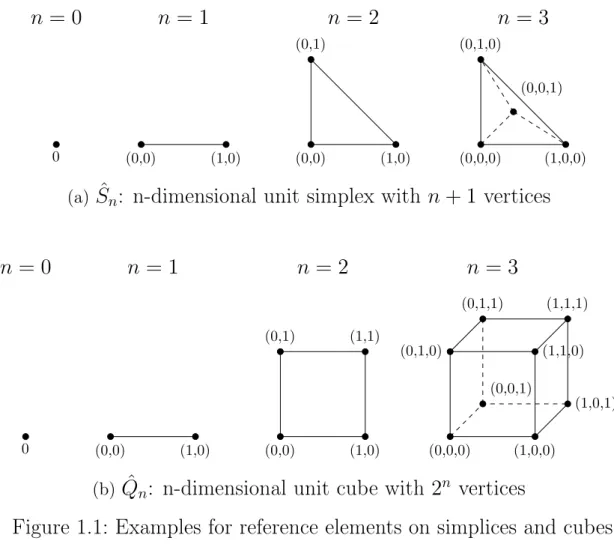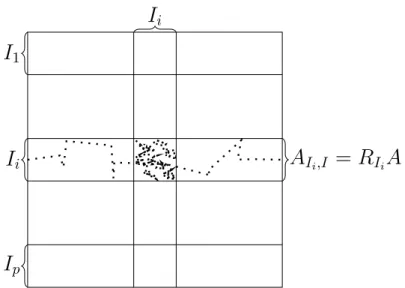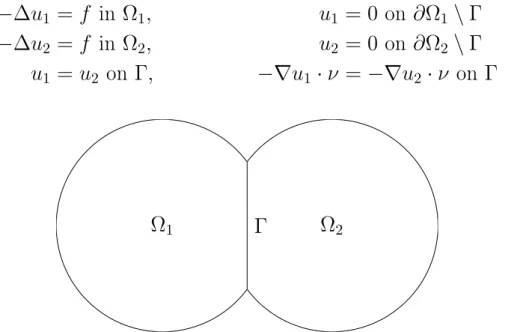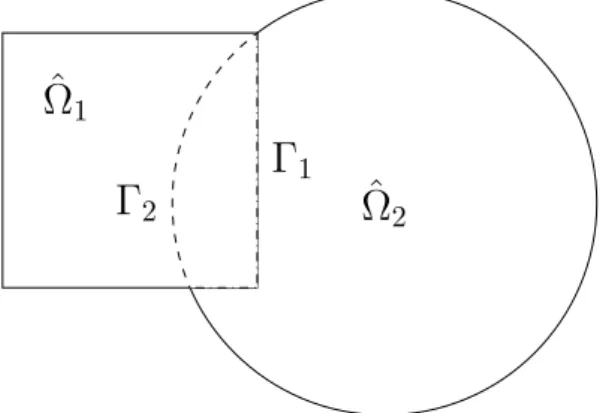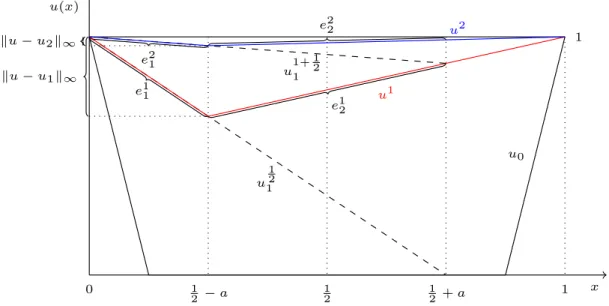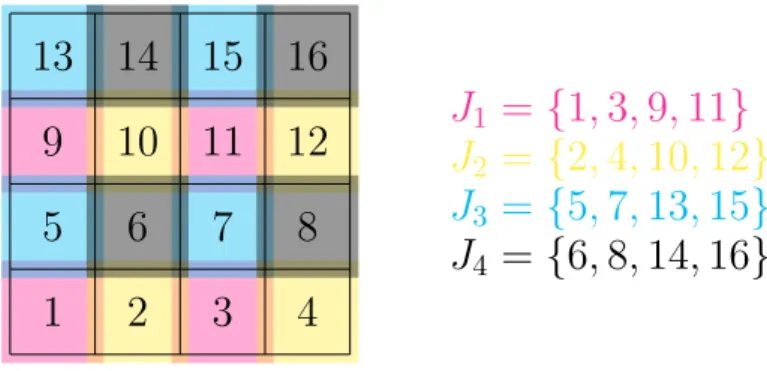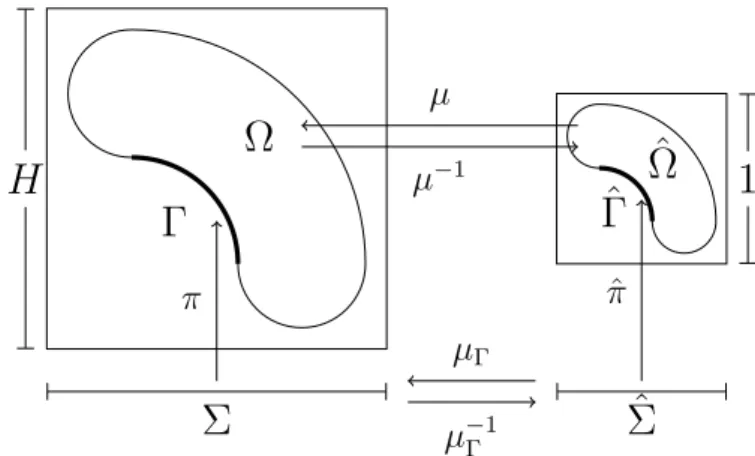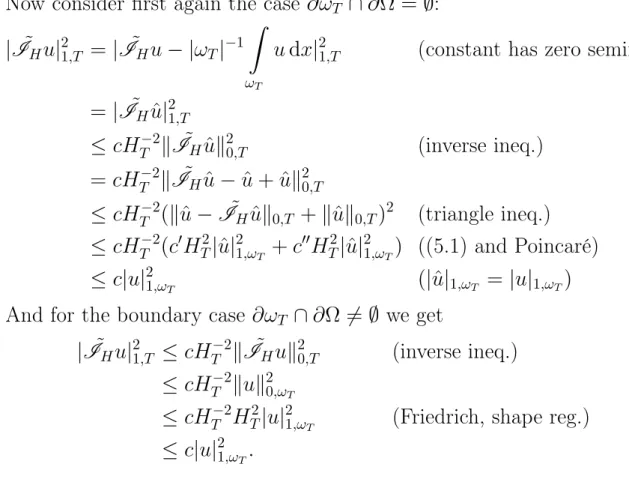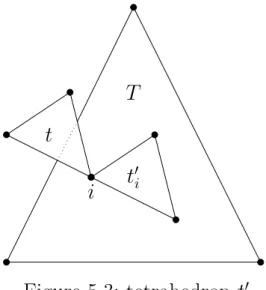Lecture Notes on
Parallel Solution of Large Sparse Linear Systems
Peter Bastian
Interdisziplinäres Zentrum für Wissenschaftliches Rechnen
Universität Heidelberg, Im Neuenheimer Feld 368, 69120 Heidelberg Peter.Bastian@iwr.uni-heidelberg.de
July 12, 2015
Acknowledgements
These lecture notes grew out of a lecture I have been giving more or less regularly since 1999. The current english version would not exist without the excellent work of Ansgar Burchardt and Judith Stein who typed the manuscript in the winter semester 2012 and summer semester 2015, respectively. I thank them very sincerely for their work. All remaining errors are of course my own.
Peter Bastian Heidelberg, July 2015
Contents
1 Recapitulation of the Finite Element Method 7 1.1 The Variational Formulation of Elliptic Partial Differential Equa-
tions . . . 8
1.2 Conforming Finite Element Method . . . 14
2 Classical Iterative Methods 25 2.1 Linear Iterative Methods . . . 25
2.2 Block Iterative Methods . . . 29
2.3 Descent Methods . . . 31
2.4 Parallel Implementation . . . 34
3 Overlapping Domain Decomposition Methods 37 3.1 Overlapping versus Non-overlapping Methods . . . 37
3.2 Overlapping Schwarz Methods with Many Subdomains . . . 41
3.3 Discrete Variational Formulation of Schwarz Methods . . . 44
3.4 Coarse Grid Correction . . . 48
3.5 Complexity Considerations and Speedup . . . 49
3.6 Numerical Examples . . . 53
4 Abstract Schwarz Theory 57 4.1 Subspace Correction Methods . . . 57
4.2 Additive Case . . . 59
4.3 Multiplicative Case . . . 63
5 Convergence Theory for Overlapping Schwarz 69 5.1 Technical Preliminaries . . . 69
5.2 Coarse Grid Contribution . . . 71
5.3 Localization to the Subdomains . . . 79
5.4 Proof of Assumptions of Abstract Schwarz Theory . . . 86
6 Multigrid Methods 93 6.1 Multilevel Finite Element Spaces . . . 93
6.2 Multilevel Subspace Correction Methods . . . 94
6.3 Sequential Implementation . . . 96
6.4 Parallel Implementation of Multigrid Methods . . . 99
6.5 A Convergence Proof for Multilevel Methods . . . 105
6.6 Algebraic Multigrid (AMG) . . . 116
7 Nonoverlapping Domain Decomposition Methods 125
7.1 Introduction to Iterative Substructuring . . . 125
7.2 Two Subdomain Preconditioners . . . 128
7.3 Many Subdomains . . . 131
7.4 Hierarchical Basis for the Schur Complement System . . . 132
7.5 Bramble-Pasciak-Schatz Method (BPS) . . . 137
7.6 Outlook: Balancing Neumann-Neumann and FETI-DP . . . 147
Bibliography 153
Chapter 1
Recapitulation of the Finite Element Method
In this chapter we want to give a short summary about the Finite Element Method, a numerical technique for finding approximate solutions to boundary value problems for partial differential equations. Introductions to the finite element method can be found in Eriksson et al. [1996]; Braess [2003]; Ciarlet [2002]; Ern and Guermond [2004]; Brenner and Scott [1994]; Rannacher [2006];
Bastian [2014].
Elliptic Model Problem: ”Strong Formulation”
Now we consider linear elliptic problems that are commonly found in mechan- ical and physical partial differential equation models. The aim is to introduce the notion of a weak formulation that gives access to existence and uniqueness results for the solutions and that is well suited for the numerical approximation of such problems.
In the theory of partial differential equations, elliptic operators are differential operators that generalize the Laplace operator. An elliptic differential equation of second order has the form
−∇ ·(K(x)∇u(x)) +c(x)u(x) = f(x) x ∈ Ω ⊂ Rn
u(x) = g(x) x ∈ ΓD ⊆ ∂Ω (1.1)
−K(x)∇u(x)·n(x) = j(x) x ∈ ΓN = ∂Ω\ΓD with the coefficient functions K and c.
We assume Ω to be open, connected and bounded. An important assumption on the coefficient K is that for all ξ ∈ Rn we have
k0kξk2 ≤ξTK(x)ξ ∀x ∈ Ω which is called uniform ellipticity and that
ξTK(x)ξ ≤K0kξk2 ∀x∈ Ω
which is boundedness. Furthermore K(x) is assumed to be symmetric and c(x) ≥ 0.
Regarding the Problem (1.1) we can investigate the following questions:
• For the problem to be well-posed we have to guarantee that – the solution exists,
– it is unique
– and stable: kuk ≤ c (kfk+kgk+kjk
| {z }
data
).
• For a numerical solution producing an approximation uh on would like to guarantee an priori error estimate of the form
ku−uhk ≤ chkkuk where h is a mesh size parameter.
• Guaranteed error control of the numerical solution requires an posteriori error estimate of the form
ku−uhk ≤ η(uh) with an η that is effectively computable.
Note that k · k means a “generic” norm in these lecture notes. More over, the strong formulation (1.1) requires very restrictive demands placed on the data (f, g, j) to answer these questions. For this reason we consider the weak/varia- tional formulation.
1.1 The Variational Formulation of Elliptic Partial Differential Equations
We describe the general abstract framework for elliptic problems with homo- geneous Dirichlet data, ∂Ω = ΓD and g = 0. To get the variational form we multiply the equation by a “test function” v(x) and do integration by parts:
Z
Ω
[−∇ ·(K∇u) +cu]v dx = Z
Ω
(K∇u)· ∇v +c uv dx+ Z
∂Ω
(K∇u)·νv ds
= Z
Ω
(K∇u)· ∇v +c uv dx (v = 0 on ∂Ω)
=: a(u, v).
This relation holds true for all test functions v(x) ∈ C1(Ω)∩ C0(Ω). The idea is now to reverse the argument and to define the function u by requiring
a(u, v) = l(v) :=
Z
Ω
f v dx
1.1 The Variational Formulation of Elliptic Partial Differential Equations for “sufficiently many” test functions v.
Put in an abstract way, the problem reads as follows. Given suitable function spaces U and V (see below) define the function uby the variational formulation:
Find u ∈ U : a(u, v) = l(v) ∀v ∈ V. (1.2) Here, a(·,·) ∈ L(U ×V,R) is a so-called bilinear form and l(·) ∈ L(V,R) is a linear functional.
Remark 1.1. L(U×V,R)is the space of continuous bilinear forms andL(V,R), is the space of continuous bilinear functionals. L(V,R) is also abbreviated by
V0 and is called the dual space of V.
The following two theorems ensure the existence, uniqueness and stability of the solution given by (1.2).
Theorem 1.2 (Banach-Nečas-Babuška). Let U and V be Banach spaces (com- plete, linear, normed spaces), let V be reflexive and a ∈ L(U × V,R), l ∈ L(V,R). Then (1.2) is well-posed if and only if
∃α > 0 : inf
u∈Usup
v∈V
a(u, v)
kukUkvkV ≥α, (1.3)
∀v ∈ V : (∀u ∈ U : a(u, v) = 0) ⇒(v = 0). (1.4) Furthermore, the following stability estimate holds:
kukU ≤ 1
αklkV0.
Additional Comments
• The dual space V0 is equipped with the norm klkV0 = sup
w∈Vw6=0
l(w) kwkV .
• a(u,·) ∈ V0 for given u ∈ U.
• The linear operator A: U →V0 is defined by Au := a(u,·).
• (1.2) ⇔ Au = l. In that sense eqref1.2 is a linear equation in function spaces.
• (1.3) ⇔ A is injective.
• (1.4) ⇔ A is surjective.
• f ∈ L2(Ω) implies that l(v) =R
Ωf v dx = (f, v)L2(Ω) ∈ V0.
Theorem 1.3 (Lax-Milgram). Let V be a Hilbert space, a ∈ L(V × V,R), (U = V!), and l ∈ V0, i.e. a(·,·) is a continuous bilinear form and l(·) a continuous functional. If the bilinear form a(·,·) is coercive ( also called V- elliptic), i.e.
∃α > 0,∀u ∈ V : a(u, u) ≥ αkuk2V,
then there exists a unique solution to model problem (1.2) and the following stability estimate holds
kukV ≤ 1
αklkV0.
Remark 1.4. bla
• The Lax-Milgram theorem is proved with the help of the Riesz represen- tation theorem (which requires V to be a Hilbert space) and the Banach fixed-point theorem.
• One can show that Lax-Milgram theorem 1.3 implies Banach-Nečas-Babuška theorem 1.2, but not vice versa.
• Note that we do not assume a(·,·) to be symmetric in order to proof well-posedness.
• For our model problem Lax-Milgram theorem is sufficient. Banach-Nečas- Babuška theorem 1.2 is needed in more complex situations. It is used to proof well-posedness to parabolic equations or even more complex systems of partial differential equations (e.g. Stokes equations).
Sobolev Spaces
In order to prove the well-posedness with the help of Lax-Milgram theorem, we have to find an appropriate Hilbert space. Such spaces are given by so-called Sobolev spaces that consist of weakly differentiable functions.
Definition 1.5 (L2(Ω)). Sobolev spaces are based on the space of functions which are square integrable in the sense of Lebesgue, i.e.
L2(Ω) =
u :
Z
Ω
u2(x)dx < ∞
.
Functions in L2(Ω) are equipped with the scalar product and norm (u, v)0,Ω =
Z
Ω
uv dx, kuk0,Ω = q
(u, u)0,Ω.
1.1 The Variational Formulation of Elliptic Partial Differential Equations L2 functions are not differentiable in the classical sense and one needs an alternative notion of differentiability. The idea is to use integration by parts to transfer derivatives to a function that is differentiable in the classical sense.
Definition 1.6 (Weak Derivative). Let α ∈ Nd0 be a multi-index, that is α := (α1, ..., αd) and |α|1 :=
d
X
i=1
αi.
Considering a function u ∈ L2(Ω), we say that u is called weakly differentiable, if a function g ∈ L2(Ω) exists, so that for all test functions φ ∈ C0∞(Ω) the following condition holds
Z
Ω
g(x)φ(x)dx = (−1)|α|1 Z
Ω
u(x)∂x∂|α|αφ(x)dx.
Such a function g is called the α-th weak derivative of u in the L2(Ω) sense and we define ∂αu := ∂x∂|α|αu := g. Here the multi-index notation
∂|α|1
∂xαu(x) = ∂|α|1
∂xα11· · ·∂xαddu(x)
has been used.
Definition 1.7 (Sobolev space Hk(Ω)). The Hilbert space of all elements u ∈ L2(Ω)with square integrable weak derivatives∂αu ∈ L2(Ω)for allα with|α|1 ≤ k is called Sobolev space of order k and will be denoted by Hk(Ω), i.e.
Hk(Ω) :={u ∈ L2(Ω) : ∂αu ∈ L2(Ω) ∀0 ≤ |α|1 ≤ k}.
The Sobolev space Hk(Ω) is equipped with the inner product (u, v)k,Ω := X
0≤|α|1≤k
Z
Ω
(∂αu) (∂αv)dx and the induced norm
kukk,Ω :=
q
(u, u)k,Ω.
Definition 1.8. The space of all linear continuous functionals u∗ : Hk(Ω)→ R is denoted by
H−k(Ω) := L(Hk(Ω),R) = (Hk(Ω))0
and is also called the dual space of Hk(Ω).
According to the Riesz representation theorem any continuous linear func- tional l ∈ H−k(Ω) can be represented by an element ul ∈ Hk(Ω) via
l(v) := (ul, v)k,Ω. (1.5) Since we consider Dirichlet boundary conditions in this lecture the following subspaces of Sobolev spaces will be of importance.
Definition 1.9 (Sobolev space H0k(Ω)). The Sobolev space of all functions van- ishing in a weak sense on the boundary of Ω is given by
H0k(Ω) := {u ∈ Hk(Ω) : u|∂Ω = 0 “almost everywhere”}.
Remark 1.10 (Subset relations). By Definition 1.7 the identityH0(Ω) = L2(Ω) follows. Moreover, we have the following relations
. . . ⊃ H−1(Ω) ⊃ L2(Ω) ⊃ H1(Ω) ⊃ H2(Ω) ⊃ . . .
∪ ∪
H01(Ω) ⊃ H02(Ω) ⊃ . . .
where the dual space L2(Ω)0 has been identified with the space L2(Ω) itself.
Regarding equation 1.5 the dual space of a Sobolev space is even bigger than
the space itself.
Remark 1.11 (Construction of Sobolev spaces). An alternative way to define Sobolev spaces is to think of them as the completion of a certain function space with respect to a certain norm. These spaces are often labeled as Wk(Ω).
It can be shown that Wk(Ω) = Hk(Ω) holds.
• For k ≥ 0 the Sobolev space Hk(Ω) is given as the completion of Ck(Ω) with respect to k · kk,Ω.
• For k > 0 the Sobolev space H0k(Ω) is given as the completion of C0∞(Ω)
with respect to k · kk,Ω.
A relation between classical function spaces and Sobolev spaces is given by the following
Proposition 1.12 (Sobolev embedding theorem). For dimensionn,k ∈ N0 and k − n2 > m there exists a continuous embedding
Wk,p(Ω) ,→ Cm(Ω) ⊂ C(Ω).
Application of Lax-Milgram-Theorem 1.3
Now, we want to apply Lax-Milgram Theorem to our model problem in order to proof the well-posedness of the problem. To do so, we have to determine
1.1 The Variational Formulation of Elliptic Partial Differential Equations an appropriate Hilbert space V and show that the bilinear form a(·,·) is coer- cive and continuous with respect to the norm of the Hilbert space. Moreover, continuity of the linear functional l is required which we will presuppose in the considered examples and can be easily achieved since f ∈ L2(Ω)already implies l(v) = R
Ωf v dx ∈ V0. The following examples differ only in the given boundary conditions.
Example: Homogeneous Dirichlet boundary conditions Let us consider- ing Problem 1.1 with ΓD = ∂Ω,g = 0, so called homogenous Dirichlet boundary conditions.
We take the Hilbert space V = H01(Ω) equipped with the inner product (·,·)1,Ω. In order to prove continuity and coercivity of the bilinear form with respect to V, we need Friedrich’s inequality, which can be proved by the funda- mental theorem of calculus and the Cauchy-Schwarz inequality.
Theorem 1.13 (Friedrich’s inequality). For every function v ∈ H01(Ω) kvk0,Ω ≤sΩ|v|1,Ω = sΩk∇vk0,Ω
holds with the diameter sΩ = diam(Ω) of the domain Ω and the semi-norm
|v|k,Ω =
X
|α|=k
Z
Ω
(∂αv)2dx 12
∀v ∈ H01(Ω).
Using Friedrich’s inequality one can show that |.|1,Ω is a norm on V and this norm is equivalent to k.k1,Ω.
Example: Pure Neumann boundary conditions Now we consider the problem with pure Neumann boundary conditions, i.e. ΓD = ∅ and ΓN = ∂Ω.
Here we use the Sobolev space V = {v ∈ H1(Ω) : R
Ωv dx = 0} with inner product (·,·)1,Ω to guarantee the well-posedness of the regarded problem. Note that this space does not explicitely include a boundary condition as it has been in the previous case. Instead we expect all functions to have a mean value equal to zero in order to assure the uniqueness of the solution. For the proof of coercivity and continuity we need:
Theorem 1.14 (Poincaré’s inequality). There exist positive constants c1, c1 such that
kvk20,Ω ≤ c1|v|21,Ω+c2 Z
Ω
v dx 2
∀v ∈ H1(Ω).
Theorem 1.15 (Trace Theorem). Assume Ω is bounded and has Lipschitz boundary. Then there exists a bounded linear operator γ : H1(Ω) → L2(∂Ω) such that
kγvk0,∂Ω ≤ckvk1,Ω ∀v ∈ H1(Ω).
In the original version the existing operator is even stronger: γ : H1(Ω) → H12(∂Ω), but the above formulation is sufficient for our purposes.
Example: Inhomogeneous Dirichlet boundary conditions As in the first example, we assume ΓD = ∂Ω but with the difference that now we have g 6= 0.
In this case we decompose our solution into a homogeneous u0 ∈ H01(Ω) and non-homogeneous part ug ∈ H1(Ω), i.e.
u = u0 + ug
and we further assume the inhomogeneous part to be an extension of the bound- ary values γug = g with the operator γ : H1(Ω) → H12(Ω) from the trace theorem. Note that this requires g ∈ H12(Ω).
With the help of this decomposition we can treat the problem similar to the homogeneous Dirichlet example:
Find u0 ∈ H01(Ω) : a(u0, v) =l(v)−a(ug, v) ∀v ∈ H01(Ω).
Mixed boundary conditions Regarding mixed boundary conditions ΓD ⊂
∂Ω,ΓD 6= ∅ we can use the Hilbert space
V = {v ∈ H1(Ω) : v = 0 on ΓD “almost everywhere”}
in order to prove well-posedness. The proof of coercivity then requires a variant of Friedrich’s inequality.
1.2 Conforming Finite Element Method
Definition 1.16 (Conformity). Let V be an adapted Sobolev space to the vari- ational problem (1.2) and Vh be the finite-dimensional Finite Element ansatz space. Then the discretization Vh is called “conforming”, if
Vh ⊂ V
or else it is called “non-conforming”.
An important characterization of finite-dimensional subspaces of Sobolev spaces can be deduced from the following theorem.
1.2 Conforming Finite Element Method
Theorem 1.17. Let Ω be a bounded domain, {ω1, . . . , ωN} a partitioning of Ω into a finite number of subdomains and Vh a space of functions such that for v ∈ Vh we have v|ωi ∈ C∞. Then Vh ⊂ Hk(Ω), k ≥ 1, if and only if
Vh ⊂ Ck−1(Ω).
In our applications we need k = 1. From the theorem we conclude that a piecewise infinitely differentiable function, e.g. a piecewise polynomial, is in H1 if and only if the function is globally continuous. The conforming finite element method comprises a specific way to construct the finite-dimensional space Vh using piecewise polynomial functions that are globally continuous.
The Lax-Milgram theorem immediately establishes the solution of the varia- tional problem
Find uh ∈ Vh: a(uh, v) = l(v) ∀v ∈ Vh (1.6) in the subspace Vh.
Any finite dimensional vector space is spanned by a set of basis functions Vh = span{ϕh1, ..., ϕhNh}.
Using the basis, for every uh ∈ Vh we have the representation uh =
Nh
X
j=1
zjhϕhj.
Inserting the basis representation into the weak discrete problem (1.6) results in a linear system of equations:
Find uh ∈ Vh: a(uh, v) =l(v) ∀v ∈ Vh
⇔ a
Nh
X
j=1
zjhϕhj, ϕhi
!
= l(ϕhi) i = 1, . . . , Nh
⇔
Nh
X
j=1
zjha(ϕhj, ϕhi) =l(ϕhi) i = 1, . . . , Nh
⇔ Ahzh = bh.
with the unknown vector zh ∈ RNh, the stiffness matrix Ah ∈ RNh×Nh and the load vector bh ∈ RNh, which are defined by
(Ah)ij := a(ϕhj, ϕhi), (bh)i := l(ϕhi).
The matrix Ah is sparse because of the small overlap of the basis functions and its elements can be computed by an element-wise evaluation of the integral.
It can be shown that Ah is symmetric and positive definite, if the bilinearform a(·,·) is symmetric and coercive.
Finite Element Mesh
An important prerequisite for the practical construction of the space Vh and its basis is the partitioning of the domain Ω. This partitioning is called a mesh or grid in finite element terminology consists of so called elements or cells:
Th = {t1, ..., tm}.
Each element ti is an open, bounded and connected subset of Rn. The parti- tioning property is expressed by
m
[
i=1
ti = Ω, ti ∩tj = ∅ ∀i, j ∈ {1, ..., m}, i 6= j.
ht = diam(t) is the diameter of an element and h := max
t∈Th
ht
denotes the mesh size.
In order to speak of convergence of the finite element approximation we actu- ally need a sequence of meshes with h → 0.
The individual elements ti of the mesh typically have simple shape and in order to simplify the calculations ti is given by a transformation from a reference element. In figure 1.1 shows different types of reference elements ˆt in different space dimensions that are used in practice: the simplex and the cube family.
Proposition 1.18 (Reference transformation). Every element ti ⊂ Rn, i ∈ Th can be obtained from the reference element ˆt ⊂Rn by using an invertible affine- linear transformation (shifting, rotation, scaling...)
µi : ˆSn or Qˆn →ti, ti = µi(ˆt) =Bitˆ+zi,
with Bi ∈ Rd×d, detBi > 0 and zi ∈ Rd.
As a consequence we have
Corollary 1.19. Ω is a polyhedral domain (polygon in two space dimensions)!
In general, nonlinear transformations µ can also be considered which then allows one to handle domains with curved boundaries but this will not be con- sidered in this lecture.
It turns out that the meshThhas to satisfy the following additional properties:
1. Regularity of structure: Two cells have at most one vertex or one edge (or one face in 3D) in common (no “hanging nodes”).
1.2 Conforming Finite Element Method
0
n = 0
(0,0) (1,0)
n= 1
(0,0) (0,1)
(1,0)
n= 2
(0,0,0) (1,0,0) (0,0,1) (0,1,0)
n= 3
(a) Sˆn: n-dimensional unit simplex with n+ 1 vertices
0
n = 0
(0,0) (1,0)
n = 1
(0,0) (1,0) (0,1) (1,1)
n = 2
(0,0,0) (1,0,0) (0,0,1) (0,1,0)
(0,1,1)
(1,1,0) (1,1,1)
(1,0,1)
n = 3
(b) Qˆn: n-dimensional unit cube with 2n vertices
Figure 1.1: Examples for reference elements on simplices and cubes 2. Regularity of form: For every cell it holds
∃c1 > 0 : ht ≤c1ρt
with the apothem ρt and the circumscribed radius ht. 3. Regularity of size: Every cell is of the same size.
∃c2 > 0 : max
t∈Th
ht ≤ c2min
t∈Th
ht.
Remark 1.20. This only make sense if we have a sequence of grids Th,ν and ν ∈ N such that hν → 0 and all constants ci, i = {1,2}, are the same for every
ν.
Finite Element Spaces
Using the mesh we now we can construct Finite Element ansatz spaces and deal with questions about the practical realization of the method. Ω is a polygon domain with the decomposition Th in triangles or rectangles (triangular pyramid or hexahedron in 3-D) and all the properties given above are satisfied.
Generally we define the following multivariate polynomial spaces of degree k or smaller:
Pnk := {u ∈ C∞(Rn) : u(x) = X
0≤|α|1≤k
cαxα},
Qnk := {u ∈ C∞(Rn) : u(x) = X
0≤|α|∞≤k
cαxα}
with |α|1 = α1 + ...+ αn, |α|∞ = maxi=1,...,nαi and xα = xα11 ·. . .·xαn. In R2 this looks like
P2k := {u ∈ C∞(R2) : u(x) = X
0≤i+j≤k
cijxi1xj2},
Q2k := {u ∈ C∞(R2) : u(x) = X
0≤i,j≤k
cijxi1xj2} With that we may define the following function spaces:
Pkn(Th) := {u ∈ C0(Ω) : ∀t ∈ Th : u
t ∈ Pnk}, Qnk(Th) := {u ∈ C0(Ω) : ∀t ∈ Th : u
t = ˆut ◦µ−1t ,uˆt ∈ Qnk}.
It can be checked that this definition is in fact proper, i.e. the requirement of global continuity does not contradict the polynomial form within each element.
The next step is to construct a basis for the finite element space. In particular, for the finite element spaces considered here, a so-called Lagrange basis can be found which is characterized by the property
ϕhi(sj) =δij, j = 1, ..., Nh,
for certain points sj. In the lowest order case k = 1 the pointssj are the vertices of the mesh Th.
Approximation Properties of FE spaces
Definition 1.21 (Lagrange-Interpolation). Given a Lagrange basis we can de- fine the Lagrange interpolation operator acting on continuous functions:
I :C0(Ω) → Pkn(Th), Iv =
Nh
X
i=1
v(si)ϕhi. Remark 1.22. Note that Ivh ≡ vh for every vh ∈ Pkn(Th).
1.2 Conforming Finite Element Method
Remark 1.23. In order to define Lagrange interpolation for Sobolev functions we need k > n2 for Hk(Ω) ⊂ C0(Ω). Then the Sobolev embedding theorem ensures that functions are continuous and pointwise evaluation is well-defined.
This means for n = 1 that k ≥ 1 and for n= 2,3 that k ≥ 2.
A cornerstone of the finite element a-priori error estimate is the following approximation property of finite element functions:
Proposition 1.24. For k ∈ N, k > min(1, n/2) and Lagrange interpolation I : Hk(Ω) → Pk−1n (Th) (note the polynomial degree is k−1!) and m ∈ {0,1}
we have the estimate
ku− Iukm,Ω ≤chk−m|u|k,Ω
with a constant c = c(n, k,ˆt,Th). In particular, the constant depends on the
size of the angles of the triangulation.
As an example consider n = 2 and k > 1 (required to make Lagrange inter- polation well-defined), i.e. the smallest k is 2 and the corresponding polynomial degree is 1 (piecewise linear functions). Then we have ku− Iuk1,Ω ≤ ch|u|2,Ω. However, the Lax-Milgram theorem establishes only a solution in H1. Thus one has to assume that a solution with “additional regularity” exists.
Regularity Assumptions
We now discuss briefly under which assumptions solution in higher-order Sobelev spaces actually do exist.
Example 1.25. For domains with smooth boundary or convex polygonal do- main Ω it has been proved that u ∈ H2(Ω).
Example 1.26. Ω has a Cs boundary ∂Ω (s times continuously differentiable parameterized), then one can show u ∈ Hs(Ω).
The regularity of solutions of problem (1.2) can be also “very low”. For this discussion fractional order Sobolev spaces are required, i.e. Hs(Ω) with s ∈ R. Example 1.27. Consider the problem−∇·(K(x)∇u) = f (in weak form) where the coefficient K(x) > 0 is discontinuous and has the following “checkerboard”
form:
K1 K2
K2 K1
Then one can show that for 0 < K1 ≤ K2 the solution satisfies u ∈ H1+α with α = 2πarctan
2√ K1K2
K2−K1
≈ 4πq
K1
K2 which approaches zero for K1 K2. Correspondingly, the convergence of the finite element method is hα which is
extremely slow and is observed in practice.
A-priori Error Estimates
We start with a very important property of the finite element solution.
Proposition 1.28 (Galerkin orthogonality). Suppose u ∈ V solves (1.2) and uh solves (1.6), i.e.
a(uh, vh) =l(vh) ∀vh ∈ Vh. (1.7) Then it follows that the error e = u−uh satisfies
a(e, vh) = 0 vh ∈ Vh.
Proof. Since Vh ⊂V, we can use vh as the test function in the original equation a(u, vh) = l(vh) ∀vh ∈ Vh.
Subtracting from this equation (1.7), we get the Galerkin orthogonality relation for the error u−uh:
a(u−uh, vh) =a(u, vh)−a(uh, vh) = l(vh)−l(vh) = 0 ∀vh ∈ Vh.
If a(·,·) defines a scalar product on V, which it does in the symmetric case, then we can conclude that the error is orthogonal (w.r.t. the scalar product a(·,·)) to all functions in Vh.
An important consequence of Galerkin orthogonality is
Lemma 1.29 (Céa’s lemma). The bilinear form a : V ×V → R, V = H01(Ω), fulfills the properties
• continuity: |a(v, w)| ≤ Ckvk1,Ωkwk1,Ω for some constant C > 0 and all v, w ∈ V and
• coercivity: a(v, v) ≥ αkvk21,Ω for some constant α > 0 and all v ∈ V. Then the error satisfies
ku−uhk1,Ω ≤ C α inf
vh∈Vhku−vhk1,Ω ∀vh ∈ Vh.
The infimum term characterizes the best approximation of u in the subspace Vh
with respect to the H1-norm.
Céa’s lemma together with the approximation property gives the a-priori es- timate.
1.2 Conforming Finite Element Method
Theorem 1.30 (A priori error estimate). For the error u−uh between the exact solution u ∈ V and the FE solution uh with the ansatz space Vh ⊂ H01(Ω) of order k ≥ 1, the polynomial degree of the ansatz functions, it holds the a priori error estimation
ku−uhk1,Ω ≤chk−1|u|k,Ω,
whereby the dimension n ≤ 3 and the solution is required to be in Hk(Ω).
In the L2-norm one can show
ku−uhk0,Ω ≤ ch2|u|2,Ω for polynomial degree 1.
Practical Implementation of the matrix Ah
In this section we want to present a systematic way to compute the entries of the stiffness matrix Ah ∈ RNh×Nh for the elliptic problem
(K∇u,∇v) = (f, v) ∀v ∈ V.
This process is called “matrix assembly”. To assemble the linear system of equa- tions,
Ahzh = bh,
we use a cell-wise computation of the necessary integrals. The definition of the matrix entry is
(Ah)ij = a(ϕhj, ϕhi) = Z
Ω
(K∇ϕhj)· ∇ϕhi dx.
Now we split the domain into elements to arrive at (Ah)ij = X
t∈Th
Z
t
(K∇ϕhj)· ∇ϕhi dx.
We calculate the contribution of one element with the help of the reference transformation µt from 1.18. On element t we have the relation
ˆ
v(ˆx) = v(µt(ˆx)) (1.8)
between the finite element function v on the element t ∈ Th and the correspond- ing function on the reference element. Recall that for affine transformations we
have µt(ˆx) = Btxˆ+zt and Bt = ˆ∇µt(ˆx) (the hat on the gradient operator means differentiation with respect to x). The transformation formula for integralsˆ
Z
t
v(x)dx = Z
ˆt
ˆ
v(ˆx)|detBt|dˆx
then establishes that we can calculate the required integral on the reference element.
In addition, from the chain rule applied to (1.8) it follows
∇v(µt(ˆx)) = Bt−T∇ˆˆv(ˆx).
Using all these relations the matrix entry can be computed as (Ah)ij = X
t∈Th
Z
tˆ
[K(µt(ˆx)) ˆ∇µt(ˆx)−T∇ˆϕˆj(ˆx)]· ∇µˆ t(ˆx)−T∇ˆϕˆi(ˆx)|det ˆ∇µt(ˆx)|dˆx.
In practice the computations are organized such that all integrals on the element tcontributing to differenti, j are computed consecutively so that the (expensive) evaluations of µt (Jacobian and determinant) can be reused. Moreover, the evaluations of (gradients of) the basis functions ϕˆhi on the reference element can be computed once and stored.
A posteriori error estimation
An important role in partial differential equations is error control. Of interest is to estimate the error between an approximate solution uh and the exact solu- tion u. For this purpose we have the “a posteriori error estimator”, which only depends on calculated quantities and the data f. The a priori error in the previ- ous section is not useful to control the error, because the necessary information about higher-order derivatives of the exact solution u are not available.
Theorem 1.31. For the error u−uh there holds the psteriori error estimate ku−uhk1,Ω ≤ c
X
t∈Th
h2tkRk20,t+ X
γ∈Fhi∪FhN
hγkrk20,γ 12
with the strong formulation of the elliptic operator R = f + ∇ ·(K∇uh)
| {z }
= 0forP1-elements
−c uh,
1.2 Conforming Finite Element Method
the jump terms over the edges γ ∈ Fhi and the error in the Neumann boundary condition γ ∈ FhN
r(x) =
([−(K∇uh)·ν] x∈ γ ∈ Fhi
−(K∇uh)·ν −j x∈ γ ∈ FhN .
The constant c depends on the mesh and the polynomial degree and is hardly
computable in practice.
Interpolation of non-smooth functions
The Lagrange interpolation requires enough regularity of the Sobolev function.
In certain situations, such as for the a-posteriori error estimate given above, on requires a finite element interpolation that can work directly on H1 functions.
One possibility is the local “Clement” interpolation 1.32:
Definition 1.32 (Clement interpolation). For every function v ∈ H1(Ω) exists the “Clement” interpolation Chv ∈ Vh:
Ch : H1(Ω)→ Vh ⊃ P1n(Th),
which is a combination of the Lagrange interpolation and the following L2-
projection.
Remark 1.33. The Clement interpolation is not a projection, i.e. ChChv 6=
Chv.
Another option is the “L2-projection” 1.34, which is orthogonal but not local.
Definition 1.34 (L2-projection). TheL2-projectionQh : L2(Ω) →Vhis defined by
(Qhv, wh)0,Ω = (v, wh)0,Ω ∀wh ∈ Vh with the estimate
kv −Qhvk0,Ω ≤ ch|v|1,Ω.
Chapter 2
Classical Iterative Methods
2.1 Linear Iterative Methods
The regular linear system
Ax = b (2.1)
is solved by constructing a sequence x0, x1, . . . with arbitrary initial guess x0 that converges towards the solution x. One way to construct linear iterative methods is via defect correction. For arbitrary xk define the error as
ek := x−xk. (2.2)
Due to linearity we have
Aek = Ax−Axk = b−Axk := dk (2.3) which is called defect. Note that dk = b−Axk can be readily computed while the underlying error ek is usually not available.
In order to arrive at an iterative method A on the left hand side of (2.3) is replaced by some approximation W, i.e. we solve W vk = dk and vk = W−1dk approximates ek. This gives us the generic form of a linear iterative method:
xk+1 = xk+ W−1(b−Axk). (2.4) Particular choices for W are
WRic = ω−1I ω ∈ R,Richardson WJ ac = diag(A) Jacobi
WGS = L+D A = L+D + U,Gauß-Seidel
Analysis of linear iterative methods is based on the error propagation equation ek+1 = x−xk+1
= x−xk −W−1(Ax−Axk)
= (x−xk)−W−1A(x−xk)
= ek −W−1Aek
= (I −W−1A)ek =: Sek The matrix S = I −W−1A is called iteration matrix.
Definition 2.1.
σ(A) := {λ ∈ C : λ is eigenvalue of A}
is called the spectrum of A and
ρ(A) := max{|λ| : λ ∈ σ(A)}
is called the spectral radius of A.
Theorem 2.2. A, W regular matrices. Then the iterative scheme (2.4) con- verges if and only if ρ(S) < 1.
Proof. See Hackbusch [1991]. Idea: ek = Ske0 and show Sk → 0. For diagonal- izable matrices this is easy to see as Sk = T DkT−1 and Dk = diag(λk1, . . . , λkN) a diagonal matrix. The argument can be extended to non-diagonalizable matri- ces.
In general it is difficult to determine ρ(S). One option is to use a norm estimate
ek+1 ≤ (I −W−1A)ek
⇒ kek+1k ≤ kI −W−1Ak kekk
for any submultiplicative matrix norm. Since ρ(S) ≤ kSk for any norm and kSk < 1 is required for convergence, the norm needs to be chosen carefully.
A special case are symmetric positive definite matrices where the spectral radius can be computed exactly and related to the condition number.
Theorem 2.3. A, B symmetric and positive-definite matrices. Then the itera- tion
xk+1 = xk+ 1
λmax(BA)B(b−Axk) converges with the rate
ρ = 1− 1 κ(BA) where
κ(BA) = λmax(BA) λmin(BA)
is the spectral condition number and λmax(BA), λmin(BA) are the extreme eigenvalues of BA.
2.1 Linear Iterative Methods
Proof. A is symmetric positive definite, so there is an unitary matrix Q such that A = QDQT with D = diag(λ1, . . . , λN) with λi ∈ σ(A) ⊂ R+. Set D12 := diag(√
λ1, . . . ,√
λN) and A12 := QD12QT. Then we have σ(BA) = σ(A12BAA−12) = σ(A12BA12). Since T := A12BA12 is symmetric and positive definite all eigenvalues of BA are real and positive. Now T is also diagonalizable and has a complete set of eigenvectors. Since σ(S) = σ(I − ω1T) = {µi : µi = 1−λωi for λi ∈ σ(T) =σ(BA)}, settingω = λmax(T)we get µi ∈ [0,1−λλmin(T)
max(T)].
So ρ(S) = 1− κ(T1 ).
For B = I we obtain the Richardson iteration W = λ 1
max(A)I. For B = A−1 we have κ(BA) = 1 and ρ(S) = 0.
The matrixB is supposed to reduce the condition number ofAand is therefore often called a preconditioner.
Now what is the condition number of A?
Observation 2.4 (Raleigh Quotient). LetA ∈ Rn×n be symmetric and positive definite. Then the extreme eigenvalues can be characterized by
λmin(A) = inf
x6=0
hAx, xi
hx, xi , λmax(A) = sup
x6=0
hAx, xi hx, xi , where h., .i is any scalar product in Rn.
Proof. 1. Let h., .i be the Euclidean scalar product. There exists Q with A = QTDQ and QQT = I. Then
hAx, xi
hx, xi = hDQx, Qxi hQx, Qxi =
PN
i=1λi(Qx)2i hQx, Qxi . From λminhQx, Qxi ≤ PN
i=1λi(Qx)2i ≤ λmaxhQx, Qxi we conclude the result.
2. Extend to hu, viM = hM u, vi = hM12u, M12vi.
Lemma 2.5. Let Ah be obtained from a Finite Element discretization of the Poisson equation, i.e. (Ah)ij = a(φj, φi), using Lagrange basis functions of P1 on a mesh of size h. Then there exists a constant c such that
κ(Ah) ≤ ch−2 and the estimate is sharp.
Proof. Let h., .i be the Euclidean scalar product. We write Ωij := supp(φi) ∩ supp(φj).
hAhx, xi =
Nh
X
i=1 Nh
X
j=1
xixja(φj, φi)
=
Nh
X
i,j=1
xixj Z
Ωij
∇φj · ∇φidx
=
Nh
X
i,j=1
xixj X
t∈Ωij
Z
ˆt
(Bt−T∇φˆj)·(Bt−T∇φˆi)|detBt|dˆx (*)
≤
Nh
X
i=1
xi
Nh
X
j=1
xj
X
t∈Ωij
chd−2
= chd−2hEx, xi
≤chd−2kExk kxk
≤chd−2kEk2kxk2
= chd−2kEk2hx, xi where
Eij :=
(1 Ωij = supp(φi)∩supp(φj) 6= ∅ 0 otherwise.
Note that kEk2 ≤ K when E symmetric and kEk∞ = K. In (*) we used the estimates
kBt−Tk ≤ c1
h, |detBt| ≤ chd and k∇φˆik ≤ 1.
Dividing by hx, xi and taking the supremum then shows
λmax(Ah) = sup
x6=0
hAhx, xi
hx, xi ≤ chd−2.
Now we give an estimate for λmin and recognize that based on the Lagrange
2.2 Block Iterative Methods
basis functions we have for any function uh = PNh
i=1xiφi: hAhx, xi = a(uh, uh)
≥ αkuhk21,Ω
= α(kuhk20,Ω+|uh|21,Ω)
≥ α(kuhk20,Ω+ 1
s2kuhk20,Ω) (Friedrich inequality: assume ΓD 6= 0)
≥ α1 +s2
s2 kuhk20,Ω
≥ α1 +s2
s2 hdhx, xi (not shown here) and thus
λmin(Ah) = inf
x6=0
hAhx, xi
hx, xi ≥ α1 +s2 s2 hd Together we obtain
κ(Ah) = λmax(Ah)
λmin(Ah) ≤ch−2.
2.2 Block Iterative Methods
These are precursor to overlapping Schwarz methods.
The following notation is handy when displaying block methods and describing the parallel implementation of iterative methods.
Index sets
An index set I is a finite subset of N0. In particular index sets need not be consecutive or starting with 0 or 1. x∈ RI is the vector having components(x)i for all i ∈ I. Alternatively identify a vector x ∈ RI with the map x : I →R.
Analogously, for any two index sets I, J ⊂ N0: A ∈ RI×J is the matrix with entries (A)i,j for all (i, j) ∈ I ×J. Alternatively: A: I ×J → R.
Subvectors and submatrices
Let I˜⊂I and J˜⊂J. Then, for x ∈ RI, xI˜ is given by (xI˜)i = (x)i for all i ∈ I˜ and for A∈ RI×J, AI,˜J˜ is given by (AI,˜J˜)i,j = (A)i,j for all (i, j) ∈ I˜×J˜.
Displaying a representation of a vector or matrix requires an ordering of the index sets, e.g. the lexicographic ordering. Also, certain iterative methods, e.g.
Gauß-Seidel, require an ordering of the index set.
Partitioning
Block methods are based on a partitioning of the index set I ⊂ N0. Let P = {1, . . . , p} be the index set of the blocks and choose Ii ⊆ I for i ∈ P such that
[
i∈P
Ii = I and Ii ∩Ij = ∅ for all i 6= j.
Block-Jacobi and Block-Gauß-Seidel
Then the Block-Jacobi and Block-Gauß-Seidel methods are defined by (WBJ ac)i,j =
((A)i,j if i, j ∈ Ik for a k ∈ P
0 else,
(WBGS)i,j =
((A)i,j if i ∈ Ik, j ∈ Il for l ≤ k and k, l ∈ P
0 else .
Assume that the index set I is ordered such that i < j whenever block(i) < block(j) where block(i) =k :⇔i ∈ Ik. Then
WBJ ac =
AI1,I1 0 . . . 0 0 AI2,I2 ...
... . .. ... 0 . . . AIp,Ip
, WBGS =
AI1,I1 0 . . . 0 AI2,I1 AI2,I2 ...
... . .. ... AIp,I1 . . . AIp,Ip
.
Both methods require the solution of the p smaller systems AIi,Ii. Algorithmic Formulation
Define the rectangular restriction matrix
RIi :RI → RIi, (RIix)α := (x)α∀α ∈ Ii.
RIi is a |Ii| × |I| matrix with exactly one 1 per row. All 1s are in different columns, so rankRIi = |Ii|.
With this we can write
AIi,Ii = RIiARITi and get for the Block-Jacobi method
xk+1 = xk +X
i∈P
RTI
iA−1I
i,IiRIi(b−Axk)
2.3 Descent Methods
where the computations can be done in parallel. In case of the Block-Gauß-Seidel method we get
For i = 1, . . . , p : xk+pi = xk+i−1p +RTIiA−1I
i,IiRIi(b−Axk+i−1p ).
Without further assumptions on Ii andA these corrections have to be computed sequentially!
For the convergence of the block variants one can prove:
Theorem 2.6. A let be symmetric positive definite.
1. 2WBJ ac −A be symmetric and positive definite then kSBJ ackA < 1.
2. kSBGSkA < 1 where kSkA is the matrix norm associated to the energy norm kxkA := p
hAx, xi.
Proof. See [Hackbusch, 1991, Satz 4.5.4 and 4.5.6].
2.3 Descent Methods
These are nonlinear iterative methods based on minimizing the functional F(x) = 1
2hAx, xi − hb, xi.
Theorem 2.7. A symmetric and positive definite. Then the unique minimum x∗ of F coincides with the solution of the linear system Ax= b.
Proof. For any x = x∗ + v show F(x) = F(x∗) + 12hAv, vi > F(x∗) if v 6= 0.
Uniqueness is proven by contradiction.
1D-minimization
Given an iterate xk and a “search direction” pk one can easily solve the problem Find α ∈ R such that F(xk +αpk) → min
by
α = (pk)T(b−Axk)
(pk)TApk . (2.5)
Gradient descent method: Choose pk = −∇F(xk) = b−Axk.
Theorem 2.8. A symmetric and positive definite. Then, with x being the solution of Ax = b, the gradient descent method satisfies
kx−xkkA ≤ κ(A)−1
κ(A) + 1kx−xk−1kA.
Algorithm 2.1 Gradient Descent Method
Given: Initial guess x, right-hand side b and tolerance < 1 d := b−Ax
δ := δ0 := kdk while δ > δ0 do
q := Ad . matrix vector product
α := hd, di/hd, qi . scalar products
x := x+αd . x update
d := d−αq . d = b−A(x+ v) =b−Ax−Av = d−Av
δ := kdk . recompute norm
end while
Proof. See [Hackbusch, 1991, Theorem 9.2.3].
The convergence factor can be written has κ(A)−1
κ(A) + 1 ≤ 1− 1 κ(A) + 1.
So for large κ(A) the convergence factor nearly the same as that of the damped Richardson method.
Preconditioning
Idea: Choose M regular and multiply Ax= bto the left with M−1 to obtain the equivalent system M−1Ax = M−1b (left preconditioning). If κ(M−1A) κ(A) then the convergence of the gradient method applied to this system is better.
However, in general, M−1A is not symmetric even when M and A are sym- metric. Assume M and A are symmetric and positive definite. Then M12 is well defined and
σ(M−1A) = σ(M12M−1AM−12) = σ(M−12AM−12).
Now transform Ax = b from left and right by Ax = b
⇔ M−12AM−12M12x = M−12b
⇔ Aˆˆx = ˆb
with Aˆ:= M−12AM−12, xˆ:= M12x and ˆb := M−12b.
Obviously σ( ˆA) = σ(M−1A), Aˆ is symmetric and positive definite and the gradient method can formally be applied to this transformed system.
